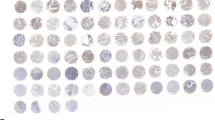Abstract
Clear cell adenocarcinoma of the ovary often shows resistance to anticancer agents. We investigated new molecules to use when developing molecular-targeting therapy for clear cell adenocarcinoma of the ovary. RMG-I cells without invasive potential and RMG-V cells with invasive potential (derived from clear cell adenocarcinoma of the ovary) were subjected to complementary deoxyribonucleic acid microarray analysis. Caveolin-1, a molecule involved in cellular motility and invasion, showed differing expression between the two cell lines. An RNA interference experiment using the published siRNA for caveolin-1 was carried out. The results showed suppression of RMG-V cell infiltration by siRNA, but proliferation of the cancer cells was also suppressed. In other words, RMG-V cell infiltration may have been suppressed simply because cell proliferation was suppressed by RNA interference. These findings suggested that POU6F1 might be a transcription factor involved in the proliferation of ovarian cancer cells. Clear cell adenocarcinoma of the ovary shows little response to standard therapy. The results of the present study suggest that the transcription factor POU6F1 could be a new molecular target for treatment of this cancer.
Similar content being viewed by others
References
Buchsbaum HJ, Brady MF, Delgado G et al. Surgical staging of carcinoma of the ovaries. Surg Gynecol Obstet 1989; 169: 226–32.
Silverberg SG. Histopathologic grading of ovarian carcinoma, a review and proposal. Int J Gynecol Pathol 2000; 19: 7–15.
Scully RE, Young RH, Clement PB. Tumors of the ovary, maldeveloped gonads, fallopian tube, and broad ligament. In: Rosai J, ed. Atlas of Tumor Pathology, 3rd Series. Fascicle 23. Washington, DC: Armed Forces Institute of Pathology, 1999; 27–50.
Enomoto T, Kuragaki C, Yamasaki M et al. Is clear cell carcinoma and mucinous carcinoma of the ovary sensitive to combination chemotherapy with paclitaxel and carboplatin? Proc Am Soc Clin Oncol 2003; 22: 447.
Takano M, Sugiyama T, Yaegashi N et al. Progression-free survival and overall survival of patients with clear cell adenocarcinoma of the ovary treated with paclitaxelcarboplatin or irinotecan-cisplatin: retrospective analysis. Int J Clin Oncol 2007; 12: 256–60.
Suzuki N, Higashiguchi A, Hasegawa Y et al. Loss of integrin α3 expression is associated with acquisition of invasive potential by ovarian clear cell adenocarcinoma cells. Hum Cell 2005; 18: 147–55.
Miotti S, Tomassetti A, Facetti I, Sanna E, Berno V, Canevari S. Simultaneous expression of Caveolin-1 and E-cadherin in ovarian Ca cells stabilizes adherens junctions through inhibition of src-related kinases. Am J Pathol 2005; 167: 1411–27.
Sanna E, Miotti S, Mazzi M, De Santis G, Canevari S, Tomassetti A. Binding of nuclear caveolin-1 to promoter elements of growth-associated genes in ovarian carcinoma cells. Exp Cell Res 2007; 313: 1307–17.
Burgermeister E, Liscovitch M, Rocken C, Schmid RM, Ebert MP. Caveats of caveolin-1 in cancer progression. Cancer Lett 2008; 268: 187–201.
Cordes N, Frick S, Brunner TB et al. Human pancreatic tumor cells are sensitized to ionizing radiation by knockdown of caveolin-1. Oncogene 2007; 26: 6851–62.
Wey E, Schäfer BW. Identification of novel DNA binding sites recognized by the transcription factor mPOU (POU6F1). Biochem Biophys Res Commun 1996; 220: 271–9.
Okamoto K, Wakayama M, Noji S et al. A novel class of murine POU gene predominantly expressed in central nervous system. J Biol Chem 1993; 268: 7449–57.
Author information
Authors and Affiliations
Corresponding author
Additional information
This research was supported by a grant for scientific research from the Ministry of Education, Culture, Sports, Science and Technology of Japan (No. 19390430) (NS).
Rights and permissions
About this article
Cite this article
Yoshioka, N., Suzuki, N., Uekawa, A. et al. POU6F1 is the transcription factor that might be involved in cell proliferation of clear cell adenocarcinoma of the ovary. Hum Cell 22, 94–100 (2009). https://doi.org/10.1111/j.1749-0774.2009.00074.x
Received:
Accepted:
Published:
Issue Date:
DOI: https://doi.org/10.1111/j.1749-0774.2009.00074.x




